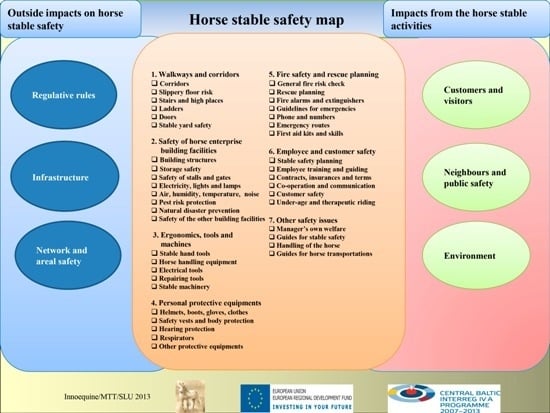Development of a Safety Management Web Tool for Horse Stables
Simple Summary
Abstract
1. Introduction
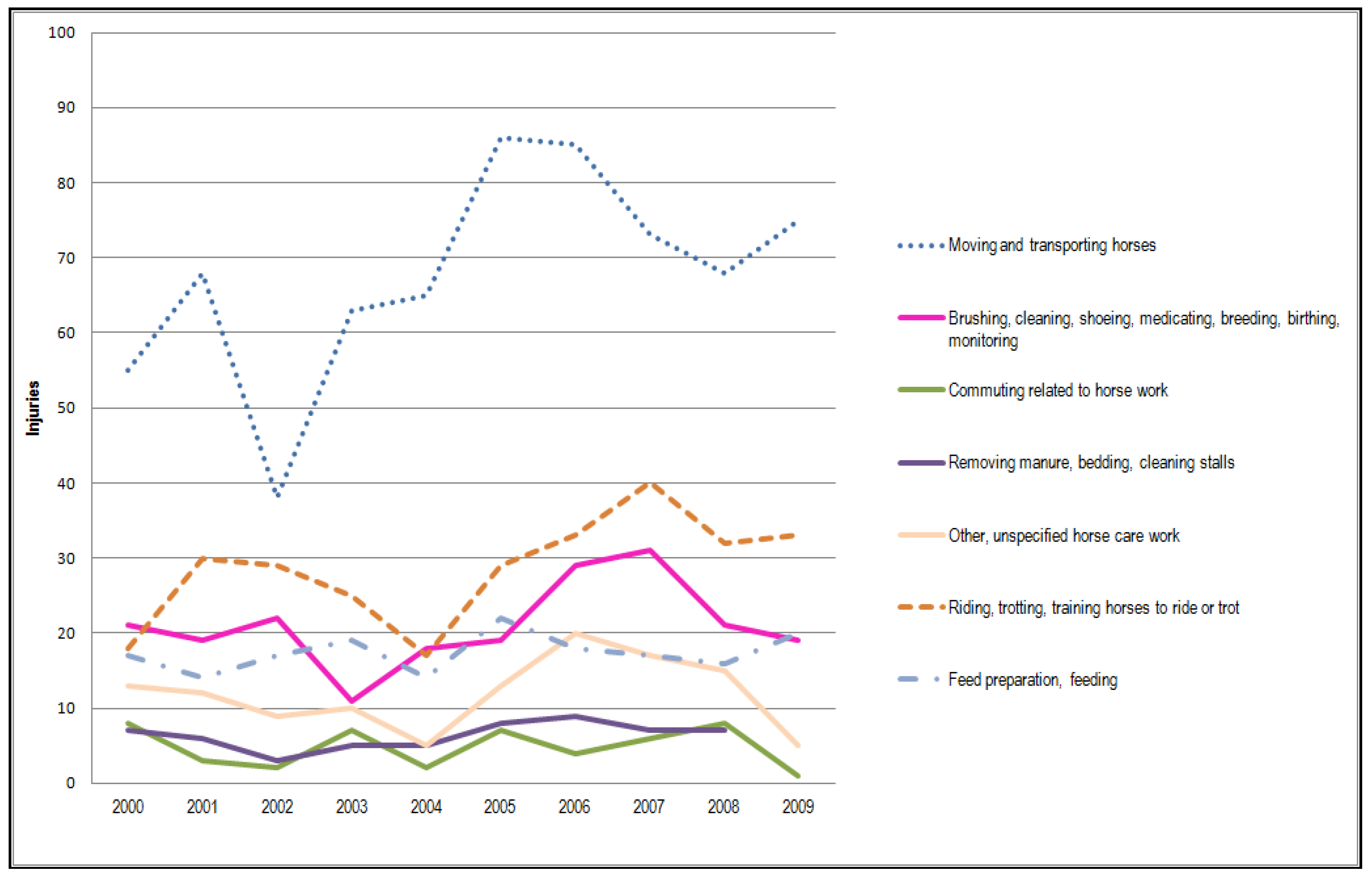
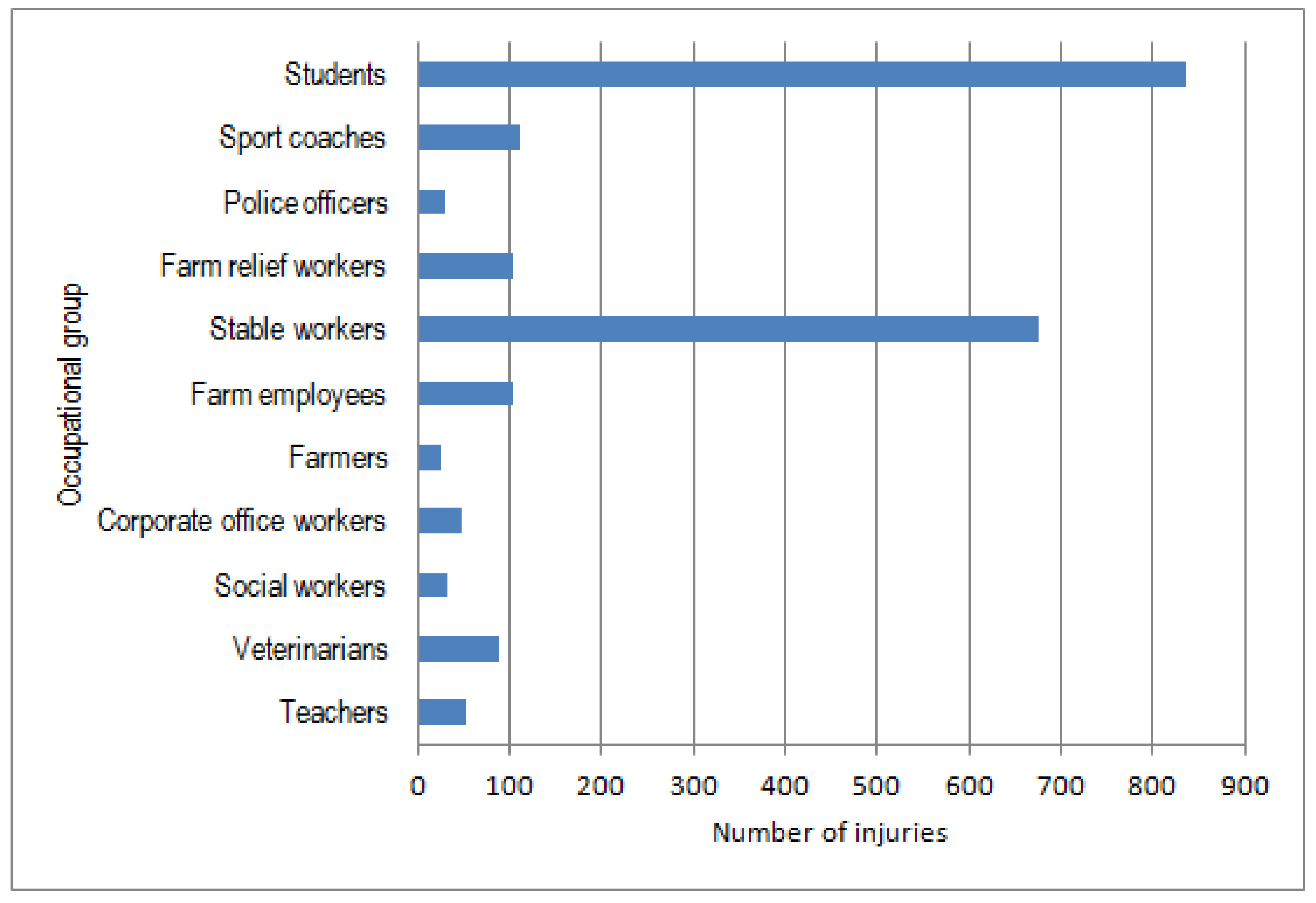
2. Data and Methods

3. Results and Discussion
3.1. The Innohorse Web Tool
3.2. Safety Section of the Web Tool
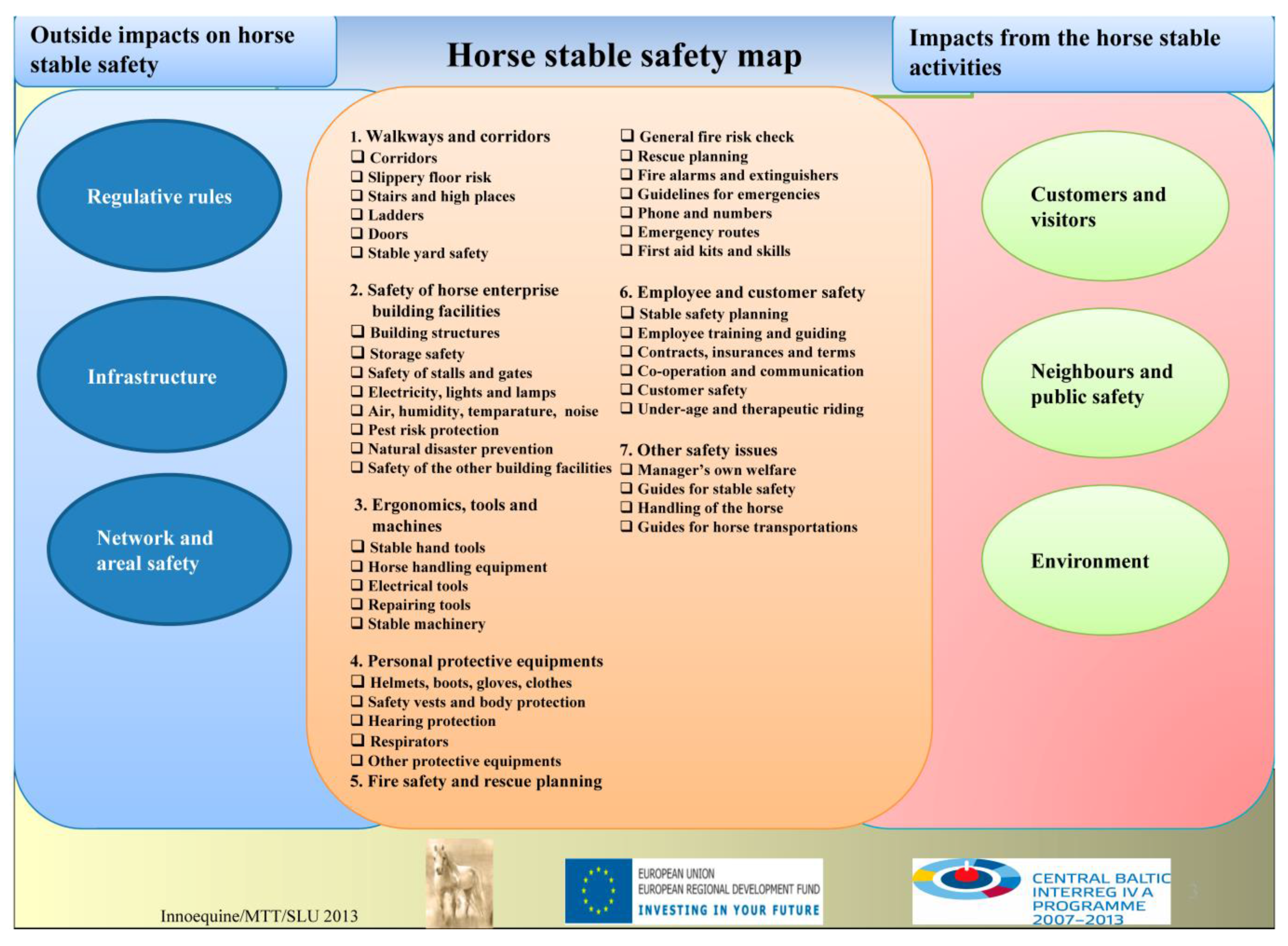
3.3. Safety Checklists and the Horse Stable Safety Map
3.4. Good Practices
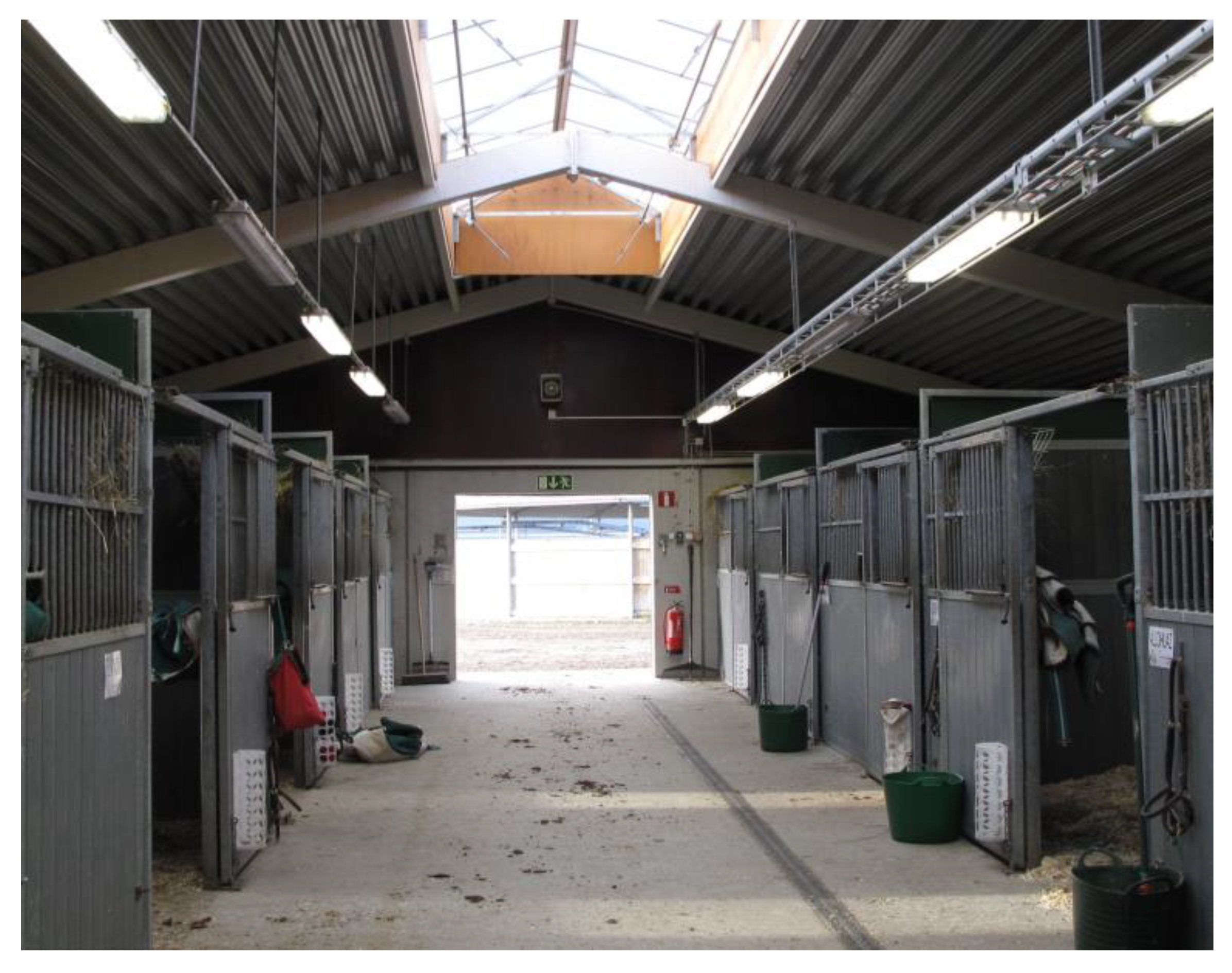
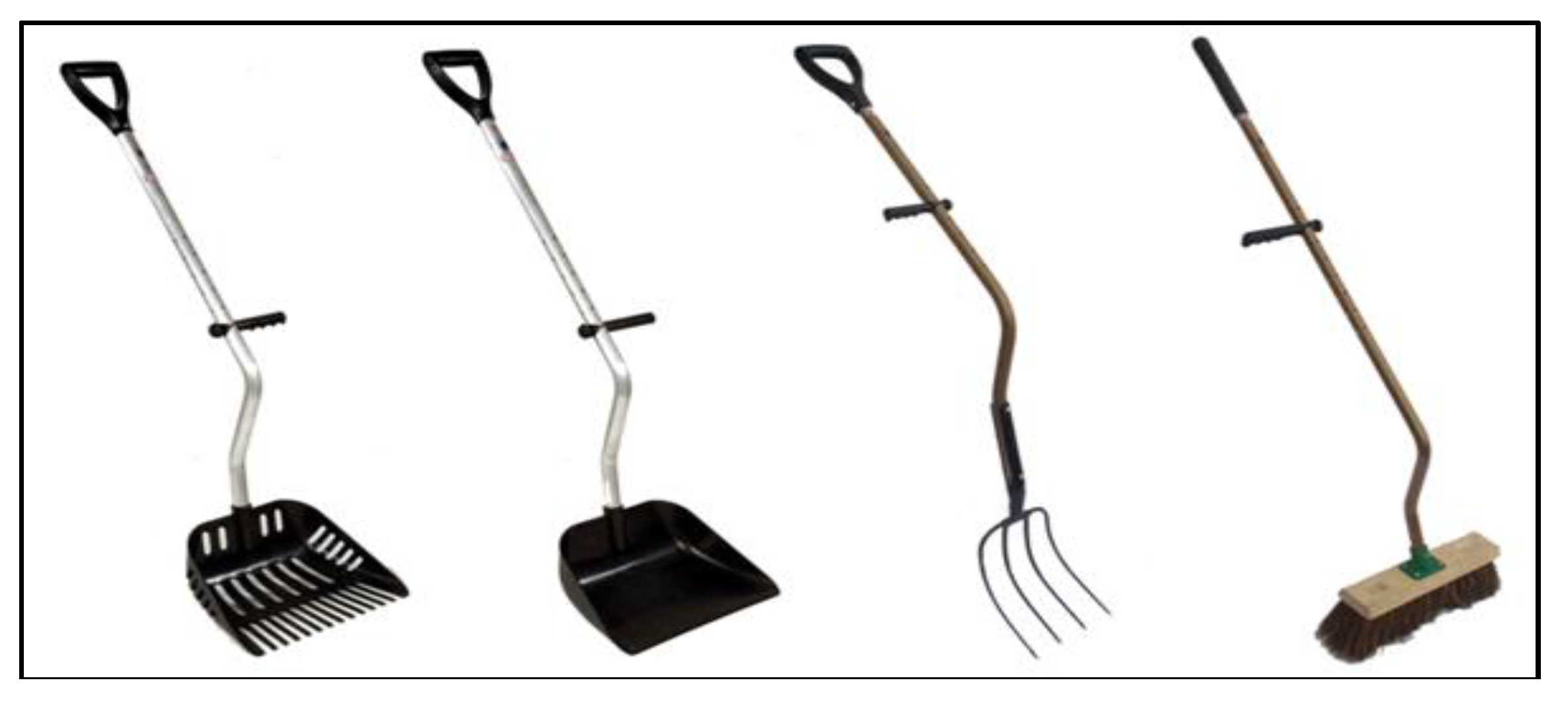
3.5. Case Study Interviews
4. Conclusions
Acknowledgments
Author Contributions
Conflicts of Interest
References
- Swedish University of Agricultural Sciences. EU Equus 2001—The Horse Industry in the European Union. 2001. Available online: http://www.horse-web.net/docs/EU_Equus_2011.pdf (accessed on 2 June 2015).
- European Pari Mutuel Association. The Economic and Social Contribution of Horse Racing in Europe. 2009. Available online: http://www.parimutuel-europe.org/Download/EPMA_Economic_impact_of_horse_racing_03Sept09.pdf (accessed on 2 June 2015).
- The Finnish Trotting and Breeding Association (Suomen Hippos). Available online: http://www.hippos.fi/ (accessed on 2 June 2015).
- Swedish Board of Agriculture (SJV). Hästhållning i Sverige 2010 (Horse Keeping in Sweden 2010); Report 1; Swedish Board of Agriculture: Jonkoping, Sweden, 2012. [Google Scholar]
- Thompson, K.; McGreevy, P.; McManus, P. A critical review of horse-related risk: A research agenda for safer mounts, riders and equestrian cultures. Animals 2015, 5, 561–575. [Google Scholar] [CrossRef] [PubMed]
- Riley, C.B.; Liddiard, J.R.; Thompson, K. A Cross-Sectional Study of Horse-Related Injuries in Veterinary and Animal Science Students at an Australian University. Animals 2015, 5, 951–964. [Google Scholar] [CrossRef] [PubMed]
- The National Equine Competence Association (Hippolis). InnoHorse—Web Tool. Available online: www.hippolis.fi/innohorse/home/ (accessed on 2 June 2015).
- Farmers’ Social Insurance Institution (Mela). MATA—Vahinkotilasto (Finnish Statistics on Farmer Injuries); Farmers’ Social Insurance: Espoo, Finland, 2012. [Google Scholar]
- Swedish National Board of Health and Welfare. Injury Data Base (IDB); Swedish National Board of Health and Welfare: Stockholm, Sweden, 2015.
- Swedish Civil Contingencies Agency. Olyckor Med Häst (Accidents with Horses). FAKTA 6 December 2013. Available online: http://www.dinsakerhet.se/Global/pdf/Fritid_resor/Olyckor%20med%20h%C3%A4st.pdf?epslanguage=sv (accessed on 2 June 2015).
- Leppälä, J.; Myllymäki, M.; Saastamoinen, M.; Rautiainen, R. Target group safety intervention and safety check tests on horse farms. In Proceedings of the Nordic Meeting on Agricultural Occupational Health and Safety (NMAOHS), Porvoo, Finland, 25–27 August 2014; p. 18.
- Tapaturmavakuutuslaitosten liitto TVL. Frequencies of Accidents at Work. Statutory Accident Insurance; Tapaturmavakuutuslaitosten liitto TVL: Helsinki, Finland, 2012. [Google Scholar]
- Leppälä, J.; Kolstrup, C.L.; Pinzke, S.; Rautiainen, R.; Saastamoinen, M. Web tool for horse stable safety practices and management. In Proceedings of the Workshop Presentation and Paper in Equimeeting Seminar, Le Lion d’Angers, France, 6–7 October 2014.
- Swedish University of Agricultural Sciences. How to Be Innovative in the Equine Sector? In A Guidebook on Practices and Inspiration from Central-Baltic; Report 2013:33; Korpa, V., Ed.; SLU: Alnarp, Sweden, 2013. [Google Scholar]
- Leppälä, J.; Murtonen, M.; Kauranen, I. Farm risk map: A contextual tool for risk identification and sustainable management on farms. Risk Manag. 2012, 14, 42–59. [Google Scholar] [CrossRef]
- Pinzke, S.; Järvinen, M.; Kettunen, K.; Lunner-Kolstrup, C.; Leppälä, J.; Löfqvist, L.; Myllymäki, M.; Rautiainen, R.; Reilas, T.; Saastamoinen, M.; et al. Säkerhet i Häststallet (Horse Stable Safety); LTJ-Report 2013:32; SLU, Work Science, Business Economics & Environmental Psychology: Alnarp, Sweden, 2013; p. 75. [Google Scholar]
- Lunner-Kolstrup, C.; Pinzke, S.; Löfqvist, L.; Järvinen, M.; Korpa, V.; Paula, L.; Kursītis, A. Current Status of the Equine Sector in the Central Baltic Region (Finland, Latvia and Sweden); LTJ-Report 2013:17; SLU, Work Science, Business Economics & Environmental Psychology: Alnarp, Sweden, 2013; p. 61. [Google Scholar]
- International Organization for Standardization. Human-Centered Design Processes for Interactive Systems; ISO 13407:1999; International Organization for Standardization: Geneva, Switzerland, 1999. [Google Scholar]
- International Organization for Standardization. Ergonomics of Human-System Interaction; ISO 9241-210:2010; International Organization for Standardization: Geneva, Switzerland, 2010. [Google Scholar]
- Kasanen, E.; Lukka, K.; Siitonen, A. The constructive approach in management accounting research. J. Manag. Account. Res. 2003, 5, 243–284. [Google Scholar]
- Committee of Sponsoring Organizations of the Treadway Commission. Enterprise Risk Management—Integrated Framework; Executive Summary 2004; Committee of Sponsoring Organizations of the Treadway Commission (COSO): City, Country, 2004. [Google Scholar]
- Juran, J.; Godfrey, A. Juran’s Quality Handbook; McGraw-Hill: New York, NY, USA, 1998. [Google Scholar]
- Löfqvist, L. Physical Workload and Musculoskeletal Symptoms in the Human-Horse Work Environment. Ph.D. Thesis, Swedish University of Agricultural Sciences, Alnarp, Sweden, 2010. [Google Scholar]
- Korkiamäki, H.; Lahin, P.; Laaksonen, K. Hevostallien työmenetelmät, case-tutkimus kuudella tallilla. In Horse Stable Work and Estimated Working Hours; Maataloustiedote 9, Report in Finnish; TTS Institute: Rajamäki, Finland, 1998. [Google Scholar]
- Laitinen, I. Manure Handling with Machinery in the Horse Stables. Master’s Thesis, Department of Agricultural Engineering, University of Helsinki, Helsinki, Finland, 2007. [Google Scholar]
- Reason, J. Managing the Risks of Organizational Accidents; Ashgate Publishing Ltd.: Aldershot, UK, 1997. [Google Scholar]
© 2015 by the authors; licensee MDPI, Basel, Switzerland. This article is an open access article distributed under the terms and conditions of the Creative Commons Attribution license (http://creativecommons.org/licenses/by/4.0/).
Share and Cite
Leppälä, J.; Kolstrup, C.L.; Pinzke, S.; Rautiainen, R.; Saastamoinen, M.; Särkijärvi, S. Development of a Safety Management Web Tool for Horse Stables. Animals 2015, 5, 1136-1146. https://doi.org/10.3390/ani5040402
Leppälä J, Kolstrup CL, Pinzke S, Rautiainen R, Saastamoinen M, Särkijärvi S. Development of a Safety Management Web Tool for Horse Stables. Animals. 2015; 5(4):1136-1146. https://doi.org/10.3390/ani5040402
Chicago/Turabian StyleLeppälä, Jarkko, Christina Lunner Kolstrup, Stefan Pinzke, Risto Rautiainen, Markku Saastamoinen, and Susanna Särkijärvi. 2015. "Development of a Safety Management Web Tool for Horse Stables" Animals 5, no. 4: 1136-1146. https://doi.org/10.3390/ani5040402
APA StyleLeppälä, J., Kolstrup, C. L., Pinzke, S., Rautiainen, R., Saastamoinen, M., & Särkijärvi, S. (2015). Development of a Safety Management Web Tool for Horse Stables. Animals, 5(4), 1136-1146. https://doi.org/10.3390/ani5040402




